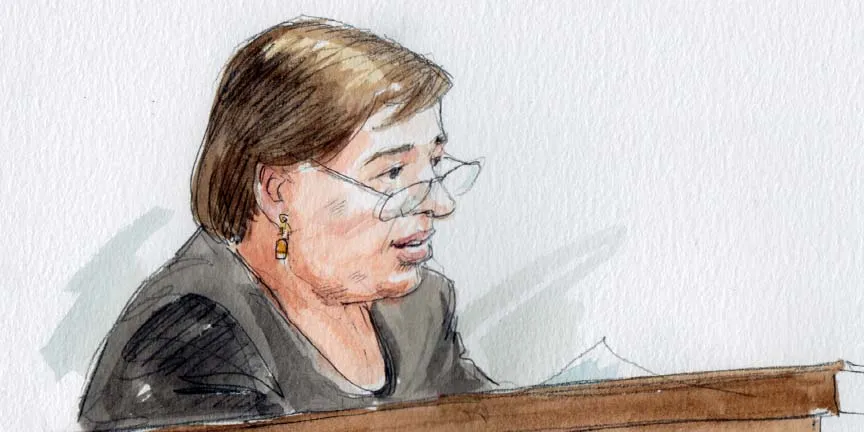Justice Kagan discusses Justice Stevens’ legacy and more

Justice Elena Kagan was at Georgetown University Law Center on Thursday afternoon for a conversation with the dean of the law center, William Treanor. With the recent passing of Justice John Paul Stevens, whose seat Kagan filled after Stevens retired, Kagan and Treanor began by discussing Stevens’ legal legacy and remarkable personal character.
In reviewing Stevens’ confirmation hearing, Treanor noted that one of the big concerns at the time was Stevens’ health, due to a recent heart attack. Kagan quipped, “Well, they didn’t have to worry.” She said that Stevens seemed “eternal,” recalling that he was still swimming in the ocean every day at 95 years old.
It is a week of mourning, but – if it’s ever appropriate to say something like “it’s also a celebration of a life” – I think it will be that, too, because my gosh, what a life. Ninety-nine years old, sharp as a tack until the day he died, went very peacefully … He was an extraordinary man and an extraordinary justice.
To take the extraordinary man part of it first, … everybody uses the same words to describe him: kind, humble, and respectful of everybody. Justice Stevens treated everybody with extraordinary dignity and had so much personal class and so much kindness.
And then a truly extraordinary justice: He served 35 years on the court, retired when he was 90 years old and still totally, actively leading a particular wing of the court. So, he was a brilliant lawyer in the kind of technical and craft aspect of the job, and at the same time he had a real passion for justice – the insistence that our legal system be fair is what really marked him.
Throughout his career, Kagan said, Stevens married fierce independence with extraordinary collegiality: “He was marked by a really strong sense of ‘I’m going to do what I think is right’, a kind of integrity in his own decision making, and a kind of independence in his own decision-making. But at the same time, he was the model of collegiality, and I think he really cared about the Court as an institution.”
Kagan remembered that when she was clerking at the Supreme Court in 1987, Stevens would pen many solo dissents and concurrences. When she read some of them, she would think, “Man, he’s got it.” Sometimes, she thought was “really too bad” that the other justices were not looking at the case in the way Stevens was, though occasionally she found the way he looked at the case to be a little too quirky.
In the last quarter of his tenure, Kagan said Stevens became the senior justice, though he was often in dissent: “It meant that some of those positions he staked out in those last years were, ‘I know the court’s gotten this wrong, but here’s the way you should think about it for the future.'”
Kagan and Treanor spoke at length about her own treatment of stare decisis, and when she thinks the court should be flexible with or even overturn precedent. Although Treanor claimed that Kagan’s track record on overturning precedent is 0-6 during her time on the court, Kagan said she does not believe that stare decisis is an inexorable rule.
Kagan spoke of her 2015 6-3 majority opinion in Kimble v. Marvel Entertainment, upholding a ruling from a half-century earlier that users cannot agree to pay royalties to a patentholder after the patent expires. She recalled that when Justice Antonin Scalia assigned the opinion to her, he said: “‘I think you should take this case, Elena, because it will force you to think about what this doctrine is really all about.'” Kagan said that offered her a great opportunity to consider when to use the doctrine and when to depart from it.
Kagan believes there is a high bar for departing from precedent, emphasizing that society relies on stable and predictable legal rules. On the whole, Kagan said, she believes cases can be overturned if, in the time since the previous ruling, it becomes clear that the precedent is “incongruous, utterly unadministrable, or, sometimes, just morally repugnant.” “The worst thing that people could think about our legal system,” she said, is “‘Oh, one person retires, or dies, and another person gets on the Court and everything is up for grabs.'”
Treanor prodded Kagan on her sharp dissent in Knick v. Township of Scott, in which she complained that the majority was “smash[ing] a hundred-plus years of legal rulings to smithereens.” Alluding to her informal voice in this dissent and others, Kagan remarked, “It is sort of fun to take shots at what you think is maybe not optimal reasoning.”
To Kagan, the purpose of many dissents is to disagree in the particular battle, not to wage an ongoing war. “You had a different view, you said the view, and now you’re back on the team again.”
But Kagan elaborated on “an obviously different type of dissent” she wrote in Rucho v. Common Cause, in which the court ruled that partisan-gerrymandering challenges cannot be brought in federal court. Kagan said the majority opinion for Rucho was “abysmally wrong.”
I didn’t pull my punches [because] there was not part of me that’s ever going to become accepting of the decision made – that the courts shouldn’t get involved in gerrymandering no matter how bad it is or how destructive it is to our political system it is.
Kagan said the purpose of her dissent in this case was to convince for the future. And “[f]or all those out there who can in some way carry out efforts against this kind of undermining of democracy: Go for it.”
